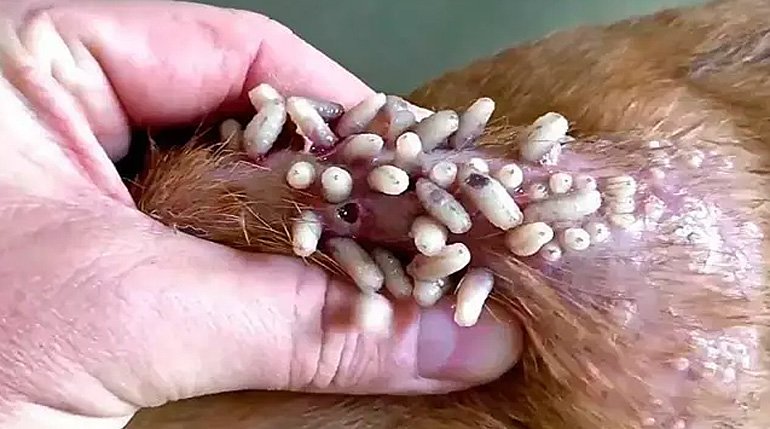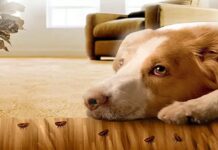Myiasis in dogs is a disease caused by the eggs of certain flies being deposited in a dog’s skin or orifices. When these eggs hatch, the larvae (maggots) feed on the dog’s tissues and fluids, causing pain, infection and even death if it is left untreated.
The dogs which are most vulnerable to this disease are those living in rural areas, although there are also many cases in dogs in the city. The best way to protect your dog from myiasis is prevention, following the tips offered here from Scooby’s Blog.
Contents
How dogs get myiasis
Flies in the order Diptera prefer to find a live host on which to lay their eggs so that, when the eggs hatch, the larvae can feed until they mature. Generally, they seek out vertebrate animals. As a result, dogs, livestock and even humans are prime targets for them.
This type of fly takes advantage of the weakness of the skin on certain parts of a dog’s body to lay their eggs, mainly moist areas and parts of the skin that remain moist for whatever reason, in open wounds or in bodily orifices.
Since there is no treatment or repellent that is completely effective, any dog can contract myiasis. For this reason, you need to check your dog and see if he is suffering from any of the common symptoms of myiasis if you want to protect him.

Types of myiasis in dogs
There are several types of myiasis in dogs, from cutaneous myiasis to aural, nasal, oral, and even anal. Of these, cutaneous myiasis is the most frequent, usually because the dog has an open wound. There can even be cases of subcutaneous myiasis, where the larvae can feed beneath the dog’s skin, even reaching his internal organs.
- Cutaneous myiasis: Dipterans take advantage of moist areas on the skin to lay their eggs, where they remain intact until the larvae inside grow and emerge.
- Aural myiasis: The fly deposits its eggs inside the ear, an area that maintains a constant level of humidity and is protected.
- Nasal myiasis: A dog’s nose is always wet because it makes it easier for them to identify smells. This is why many flies use the nose as a place to lay their eggs.
- Oral myiasis: Dipterans will even lay their eggs in a dog’s mouth because it stays moist and the larvae can feed on tissue and even the food eaten by the dog.
- Anal myiasis: It’s not unusual to find cases of myiasis in a dog’s anus because eggs laid in the anal cavity usually go unnoticed, allowing them to mature. The same is true of the eyes, where flies may also deposit their eggs.
Symptoms of myiasis in dogs
Also known as flystrike or blowfly strike, myiasis presents very clear symptoms when on the skin but which may be hard to see in certain body cavities on your dog.
Because of this, if you have any doubt, it’s essential to see a veterinarian. With their training and experience, they will be able to tell you if it is myiasis or some other type of parasitic infection. The most noticeable symptoms of myiasis in dogs are:
- Formation of furuncles or boils on the skin of the affected area
- Appearance of larvae (maggots)
- Skin ulcers and edema that don’t go away
- Intense itching of the anus (pruritus)
- Fever
- Constant itching, discomfort
- Diarrhea or substantial weight loss
If you notice one or more of these symptoms in your dog, or even if you think you see anything worm-like moving under his skin, don’t hesitate to contact your vet as soon as possible.
Treatment for myiasis and home remedies
Your vet will assess the severity and condition of the myiasis infection, remove the maggots from your dog and prescribe medication such as ivermectin. Most dogs respond well to this treatment, although if the infection is very severe, they may die.
Being that it is a very serious parasitic infection, we do not recommend under any circumstances the use of home remedies or treatments without professional veterinary supervision. Myiasis is difficult to eradicate, and you could be doing more harm than good. Besides, it’s a very painful disease, so it’s not the time to play doctor.

How to protect your dog from myiasis
The best prevention is to examine your dog periodically, especially if he has an open wound or lives in a rural area, where he’s more likely to be wet or have parts of his skin consistently moist.
We always recommend a routine weekly checkup of your dog, examining his nails, eyes, ears, skin, fur, etc. If during this checkup you see anything that seems strange, you should consult your vet to make sure it’s nothing serious.
It’s our responsibility to care for our dogs and their health, and a weekly checkup will only take up ten minutes of your time.
Is myiasis contagious?
Yes, myiasis can be spread to other animals and even to humans. That’s why it’s so important to detect it and treat it with medication according to the veterinarian’s instructions. If your dog has myiasis, it is contagious and other dogs or humans could catch it.
If a livestock animal has myiasis, your dog could catch it from that animal, too. Myiasis is highly contagious because maggots are always looking for a host on which to feed—their survival depends on it. On YouTube, you can find many videos on myiasis in dogs, but we don’t necessarily recommend watching them because they contain very graphic images.





